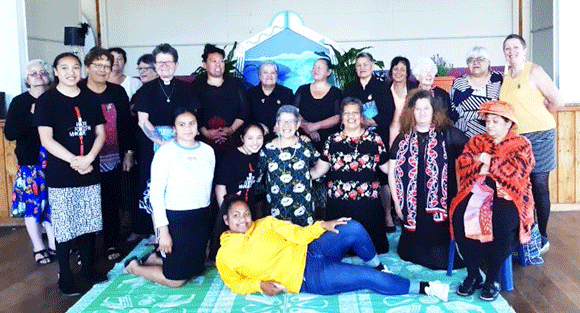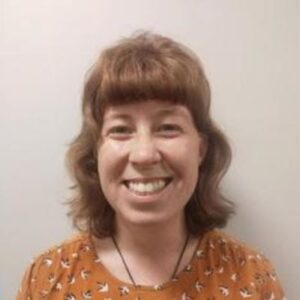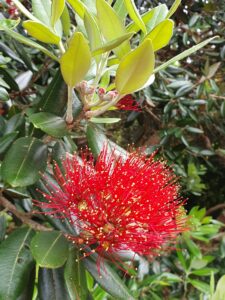Tikanga Maori Anglican Women Hui 2019
report by Deb Cole, photos by Deb Cole and Numia Tomoana
On Friday 29th November, 22 wāhine representing Tai Tokerau, Te Manawa o Te Wheke, Te Tairawhiti, and Te Waipounamu arrived at Waipatu Marae,Hastings, Hawkes Bay for the pōwhiri to open the first Tikanga Māori Women’s Studies Centre hui. This roopu of wāhine included four rangatahi kōhine who had come to be immersed in the world of their kuia o te Haahi, and haukainga, very exciting.
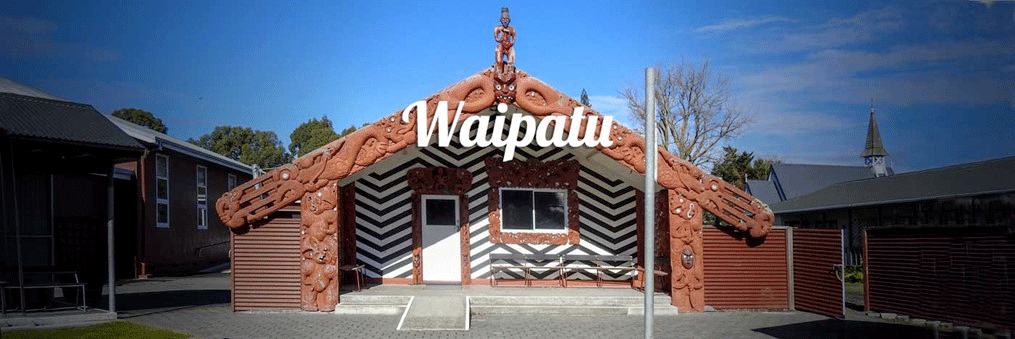
What a beautiful setting, what an auspicious moment and what faithful and wonderful wāhine to be in the company of, especially our first Pīhopa wahine, ko Waitohiariki Quayle. Also, to have Aunty Aggie Smith travel down from Kaitaia with whaea Norma Evans to give her tautoko to Rev Jenny and the contingent from Tai Tokerau, and to the wider gathering of wāhine and kuia. It was a blessing. Yes, an auspicious start to what would prove to be an incredible and enlightening hui for us.Let me say, Waipatu Marae is on whenua second to none.

‘The arrival of our first national hui was here, happening on my marae, Waipatu, in Hastings. So much excitement. The peels and calls of the karanga wove its whakapapa, wairua and tapu, around and within our manuhiri, to acknowledge our Creator, our tipuna, and our loved ones in the heavens.’ Numia Tomoana
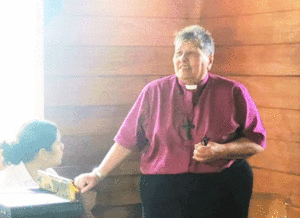
Pīhopa Waitohiariki
Back to the hui. After a wonderful lunch presenting the best of fruit and vegetables from Heretaunga, it was off to the church to hear Pīhopa Waitohiariki give her story of how she got to be where she is today.
She left us with a challenge: to be a people of excellence: that we be the best people of God we can be, this incorporates our actions, our speech, our delivery of the Gospel message and even how we dress. This kōrero reinforced the Kaupapa “Light beyond the horizon” and set the standard of excellence that was followed by the other presenters.
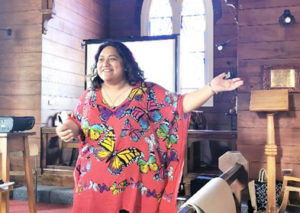
Ruihana Paenga
Ruihana spoke of her journey from grassroots community on to a global stage, at the United Nations, and then how to bring that back to her community; this was also about stepping up to be our best self, not settling for the mediocre. Thank you Ruihana for stepping off a plane direct from Bangkok and coming to fulfil your obligations before travelling back to Tairawhiti to be licensed as a Kaikarakia. Very impressive.
Associate Professor Khylee Quince spoke about leadership from within the community
The imagery was of the waka and those on the waka who, whilst having a vision of an island beyond the horizon do not make the vision the primary focus of the mahi to be completed by those in the waka; rather the rangatira and all on board are absorbed with what is happening in and around the waka, the weather, the wind, the stars and moon, the sun, the birds, the waves, the temperature of the water; that all these aspects are in alignment: mindfulness if you will. The outcome of this focus is that we don’t move towards the island, we let it come to us.
Revd Jenny Quince
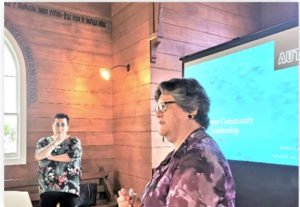
Jenny helped by others, presented on healing, on what happens to us when we are not prepared, when we do not protect ourselves spiritually, when we take on burdens that are not our own, not ours to hold on to but rather we forget that we are often the channels through which the burdens are taken to God. Jenny moved on to the armour of God and why it is important that we put it on especially when we enter into tapu situations:
- The helmet of salvation: “We believe that it is through the grace of our Lord Jesus that we are saved …” Acts 15:11
- Breastplate of righteouness: “The one who does what is right is righteous, just as He is righteous” 1 John 3:7b Belt of Truth: “You shall know the truth and the truth shall set you free” John 8:33
- Feet fitted with readiness that comes from the gospel of peace: “Peace I leave with you; my peace I give you. I do not give to you as the world gives. Do not let your hearts be troubled and do not be afraid.” John 14:27
- Shield of faith, to quench the flaming arrows of the evil one: “Now faith is confidence in what we hope for and assurance about what we do not see” Heb 11:1
- Sword of the Spirit which is the word of God: “For the word of God is living and active; sharper than any two- edged sword, piercing to the division of soul and of spirit, of joints and of marrow, and discerning thoughts and intentions of the heart.” Heb 4:12 The only offence weapon in our arsenal .
- And pray in the Spirit on all occasions with all kinds of prayers and requests.
With this in mind, be alert and always keep on praying for all the Lord’s people. Remember: “The angel of the Lord encamps around those who fear Him, and he delivers them.” Ps 34:7

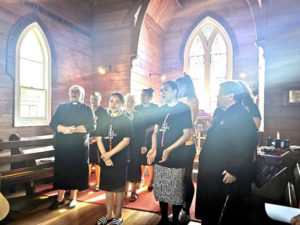
As it is with Māori gatherings, they are twofold: there is the spiritual feeding that takes place
- ko te Amorangi ki mua – the work of the Spirit of God which also enabled whanaungatanga
- ko te hapai o ki muri – the renewal of the bonds of peace that bind us together as Māori wāhine, Christian Māori wāhine, Christian Māori wāhine o Te Haahi.
Even though there were many who were unable to attend for a variety of reasons there was a core group that were able to reconnect. Then there is the physical feeding that takes place.
Rev’d Numia did an amazing job logistically, also the manaaki-tanga by the haukainga of Waipatu Marae was superlative, and thus the hui excelled in both.
After the presentations on Saturday, Numia had arranged for a Hikoi Haukunui o Heretaunga, with Kaumatua Ngahiwi Tomoana as our tour guide. He pointed out physical sites and gave us the whakapapa of these, and a rātou ingoa tūturu.
This tour included a trip up Te Mata Peak to survey the lands of Heretaunga, then to Craggy Range Wineries for wine tasting, where the view of the controversial zig-zag tramping path is seen, illegally and immorally erected by the Winery but challenged, and eventually won by the iwi. The track on this cultural heritage and sacred site is now under remedial restoration.
The end of this bus tour was Karakia at Ātea-a-Rangi, Waitangi, The Star Compass, a site that honours the ce-lestial navigational technique passed down through gen-erations for thousands of years. The site honours the tūpuna who travelled Te Moana- nui-a-Kiwa for thou-sands of years before finally landing in Aotearoa. This site was also where Te Tiriti o Waitangi was brought and signed in 1840.

I want to acknowledge Te Manawa o Te Wheke, Tairāwhiti, Te Wai Pounamu and Te Taitokerau for their inspired leading of the morning and evening praise and worship karakia: karakia that aided in setting our day on the right course and then ending our day, being able to leave the things of the day behind and rest peacefully through the night. Yes, our spirits, our minds and our bodies were fed.
What was evident from the kōererorero amongst the wāhine was that the impact of colonisation on the various communities that we all represent, is still reverberating down through whakapapa, witnessed in the disenfranchisement of our rangatahi kōhine from tikanga, from whānau, from wairuatanga o te Haahi, especially in those more rural communities where there is limited resourcing at all levels of life. Whilst the AWSC aspires to encourage our wāhine to scholarly excellence, the reality is that many of the communities struggle to reach our disenfranchised rangatahi wāhine, and perhaps there is the need to look more to resources that bring about equity of opportunity, so that all tikanga can ensure there is an equality of access by all.
Ki a koe Rev Numia me te haukainga o Waipatu Marae, te Pīhopa o Te Ūpoko o Te Ika, ngā kaikawe kōrero kauanuanu, ngā kuia, ngā wāhine o Te Pīhopatanga o Aotearoa tēnā koutou, tēnā koutou tēnā koutou katoa.
Numia
